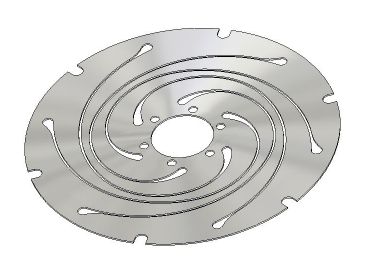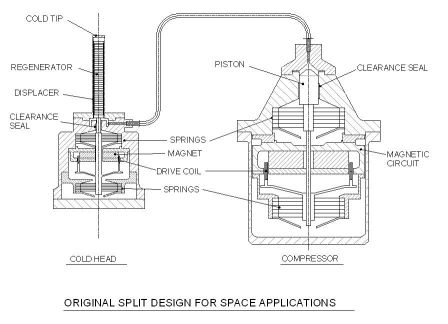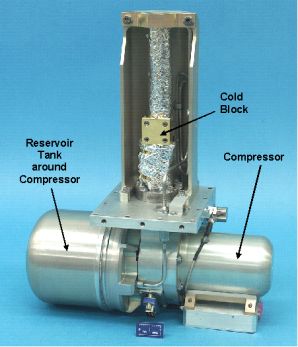| Issue 6 |
In the late 1970s there was a desire to learn more about the Earth's atmosphere, and a satellite instrument called ISAMS (Improved Stratospheric And Mesospheric Sounder) was designed to measure the vertical profiles of temperature in the atmosphere and also a number of the atmospheric constituents.
The signal-to-noise ratio of this instrument would be enhanced if the sensor was kept at a temperature of about 80 K. On the face of it this seems easy - space is a very cold place - but in fact, satellites are NOT cold. Because of the size and mass of radiators, satellites are typically at about 300 K, so a sensor at 80 K would need to be cooled in some way. The thermodynamic cycle most suitable for this was the Stirling cycle, a gas cycle which, in theory, approaches the ideal 'Carnot' efficiency.
Originally developed for producing power, the Stirling cycle can also be used for refrigeration. The main components are a compressor, which produces pressure pulsations, and a cold head, which contains a 'displacer piston' and heat exchangers. The displacer is synchronised with the compressor piston and is usually operated at a phase angle of about 90° to the compressor piston. Hence when the gas is expanding, much of the gas is at the cold end, and takes in heat from its surroundings, and when it is compressed, the gas has been moved to the warm end, where heat is rejected. By this means heat is pumped from a low temperature to a high temperature.
The specification for this cryocooler was:
The last requirement was the problem. A simple single cylinder reciprocating machine has at least five bearings, and all of these need to be lubricated. With the 'cold end' of the cryocooler at 80 K, any oil would solidify and block the heat exchangers. Therefore the unit must be oil free.
There are a variety of oil free compressors - oil separators, ceramic pistons and metal or rubber diaphragms have all been used, but all of them would need periodic maintenance to survive ten years.
The solution to this was provided by Dr Gordon Davey, who adapted a 'Pressure Modulator' developed by Oxford's Atmospheric Physics Department. The key features of the new cryocooler were:
Clearance Seals are not seals - they are leaks! If the radial clearance between piston and cylinder is made small enough, the resulting leakage can be tolerated. The clearance needed is 10-20 µm, and this requires both piston and cylinder to be very cylindrical, with good concentricity maintained between them.
Spiral Disc Springs are used to maintain the alignment of the piston within the cylinder (see Figure 1). They are photoetched from thin sheet - an inexpensive process which can easily generate the curved shapes required. The spring arms defined by the slots act as cantilevers 'built-in' at both ends. Axially the springs are compliant, allowing the piston to move up and down in the cylinder, but radially they are stiff, so that the piston remains aligned concentrically in the cylinder. A 10 year design life at 50 Hz is equivalent to 1.6 x 1010 cycles, so the material used for the springs - usually austenitic stainless steel or beryllium copper - must have a "fatigue limit", and the spring is designed so that the peak stress is safely below this limit.

|
| Figure 1: Spiral disc spring |
Linear Motion. A 'loudspeaker' type moving coil, permanent magnet motor is used to drive the compressors. With the motor, piston and springs all aligned on a common axis, there are negligible sideways forces during operation. A typical assembly suspended on spiral springs would have a radial movement of ± 3 µm for a stroke of ± 5 mm.
A diagram of this machine is shown in Figure 2. The compressor has a moving shaft mounted on two stacks of springs, with a moving piston in the cylinder at the top. The motor is positioned between the two spring stacks. The cold head is of similar design, with the displacer housed in a 'cold finger', the tip of which is connected to the sensor being cooled. The regenerator, which stores heat as gas passes between the hot and cold ends of the displacer, is housed within the displacer.
Machines to this basic design were made by the Rutherford-Appleton Laboratory and by Oxford's Atmospheric Physics Department and flown on the ISAMS and ATSR experiments, and the design was also developed by British Aerospace (and then Matra Marconi and Astrium), Lucas, Ball and Hughes/Raytheon and several other companies.

|
| Figure 2: Schematic of an early split Stirling cryocooler |
The first generation machines were expensive to make and difficult to assemble, and there was a requirement for smaller, lower cost machines that would be suitable for non-space use. To meet these requirements, an 'Integral' cryocooler was developed, which had the following characteristics:
These units were developed in partnership with the Hymatic Engineering Company (now Honeywell Hymatic) for 'tactical' and commercial markets, and there was also a transfer of technology to TRW (now part of Northrop Grumman Space Technology (NGST)). These licensing agreements are made through Isis Innovation, the University of Oxford's technology transfer company.
TRW had a requirement for a compressor to drive a cold head, but with tight restrictions on the diameter and length of the compressor. To achieve this, a new moving coil motor was designed, and improvements were made to the spiral disc springs. The original design developed into a back-to-back configuration with two identical compressors acting on a common cylinder space, and this was used as the basis for the High Efficiency Cryocooler (HEC), shown in Figure 3.

|
| Figure 3: Northrop Grumman's HEC cryocooler |
To develop this new machine, a three-way collaboration was established between:
These machines were made using a carefully controlled production process, with extensive in-process and acceptance testing. Over 20 of these 'flight' compressors have now been produced - this may not seem a large number, but by the standards of space hardware it is huge.
From the original machine, which was a 6 cm3 balanced compressor, a range of units have been developed from 26 cm3 (the High Capacity Cryocooler - HCC) to a 0.6 cm3 "Mini" unit. These compressors are typically mated to a 'pulse tube' cold head, which uses simple plumbing (typically an orifice and an 'inertance' tank), rather than a mechanical displacer, to give the correct pressure-volume phase relationship at the cold head.
In a collaboration with NGST, Hymatic and NASA's Los Alamos laboratory, one of the compressors was used in a Thermo Acoustic Stirling Heat Engine. The TASHE was a prototype for a prime mover to supply power for deep space or planetary missions, which would use plutonium as a heat source.
In a thermo-acoustic engine, a high temperature gradient can excite acoustic oscillations in a gas. If this source of sound is connected to a piston which resonates at the same frequency, it is possible to get power out of the system.
In this prototype TASHE, an HEC compressor was modified by increasing the size of the pistons, and these were mated to a thermo-acoustic engine: instead of converting electricity into pressure pulsations, the compressors acted in reverse - absorbing acoustic power and generating AC electricity. The complete system achieved a thermal efficiency of 18% with an electrical power output of 40 W.
All of the machines mentioned so far have an oscillating flow - the compressors are "AC" devices used to produce a pressure oscillation. By adding valves, these compressors can be used to create a "DC" flow through a system. One application for this is in conventional vapour compression refrigeration, or to produce a flow for a Joule-Thomson (J-T) cooler.
An example of the latter is a system being developed by NGST to cool the Mid-Infra-Red Instrument (MIRI) on the James Webb Space Telescope - the successor to the Hubble. The MIRI instrument requires 65 mW of cooling at 6 K, and the system being developed consists of a three stage pulse tube cooler powered by an HCC compressor, which is used to pre-cool the bottom stage, which is a J-T system with a valved HEC compressor.
The prototype valved compressor was built by Oxford and Hymatic, and is being tested on the complete J-T system by NGST.
Oxford has just started a new project which will further develop the valved linear compressor. Computers have reached the stage where performance is being limited by the heat generated in CPU chips. Because they are very small, the heat flux required to cool them is higher than can be obtained with a forced convection heat sink clamped to the top surface.
Suitable heat fluxes can be obtained by evaporative cooling, especially if a very fine extended heat transfer surface can be formed into the surface of the chip, which would become the 'evaporator' of a conventional vapour compression refrigerator. The problem with an 'off-the-shelf' system is the presence of oil, which circulates with the refrigerant, and would quickly find its way to the fine extended surface, which it would block.
The Oxford compressors provide a solution to this problem - the clearance seal/spring system requires no lubrication and produces no debris that would foul the extended surface. Oxford has just started a three-year project, in collaboration with Newcastle University and London South Bank University, to develop this technology.
The moving coil compressors used to date are too expensive to be used in applications such as these, so a new low-cost moving magnet linear motor has been designed. Instead of magnetic yokes machined from pure iron, and delicate moving coils, the new motor uses silicon-iron laminations and conventional windings similar to those in a standard rotary motor.
There are several other benefits of oil free compressors.
No.
But they should last a long time; there are very few failure mechanisms in these simple machines - the springs are unlikely to fail, there is no wear and no oil or debris to cause blockages.
There is the potential for electrical failure within the machine, particularly soldered joints, but failure of external controls and drive electronics is much more likely.
The one definite failure mode is gas leakage. Space cryocoolers are typically tested to ensure that the leak rate is less than 5 x 10-7 mbar l/s, which is equivalent to a pressure drop of about 1% in 25 years; pressure drops of 5% or so would be tolerable before the efficiency would fall significantly.
Life test data compiled for "Oxford" type machines in 1998 showed a total of 49 machine-years with no failures. More recent data from cryocoolers flown on satellites shows one failure in 38 machine-years (this was a displacer failure - the compressor was OK).
The future prospects of the "Oxford" compressor are very promising. The third generation compressors are very compact and robust, and have a high performance. They have been used for valved compressors and as a part of a heat engine. The new moving magnet concept will lead to a lower cost machine, and this will encourage its much wider use.
| << Previous article | Contents | Next article >> |
| SOUE News Home |
Copyright © 2007 Society of Oxford University Engineers |
SOUE Home |